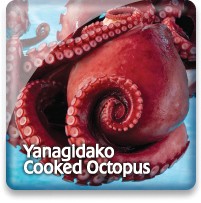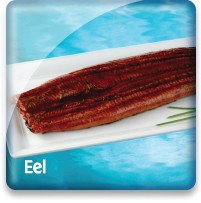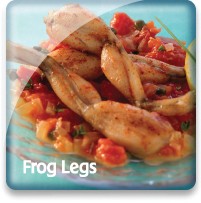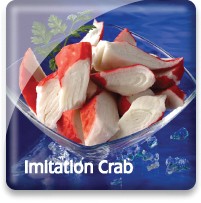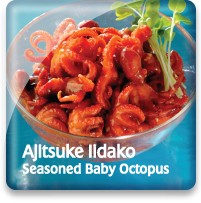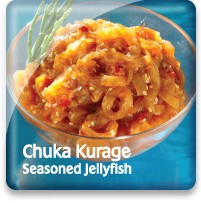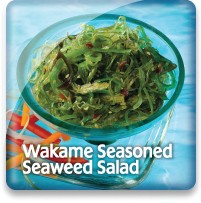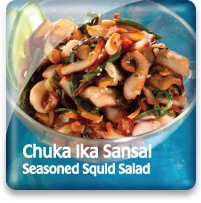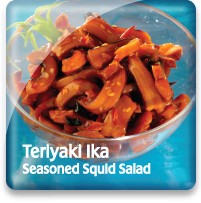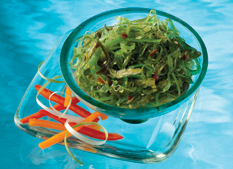
Seasoned Seaweed Salad (Wakame)

Market Name: Eating QualitiesOur Seasoned Seaweed Salad is very nutritious and tasty. It can stand alone as a healthy side dish or be added to soups and salads.
   |
Description & CharacteristicsWakame, Undaria pinnatifida, is a type of sea vegetable, or edible seaweed. Wakame fronds are green and have a subtly sweet flavor and slippery texture. The added ingredients give it a sweet and spicy flavor.Wakame has a very high nutritional value, containing many vitamins and minerals. Seaweed Salad is mixed with crystal clear of Agar-Agar, chewy woodear mushroom, and fresh chilis.
Although it looks like a plant, wakame (like other seaweeds) is actually a type of complex algae.
Other Resources |
Handling Instructions for Seasoned Seaweed Salad (Wakame)
Seasoned seaweed salad should be stored frozen at or below 0°F (-18°C) and then thawed properly when ready eat.
Thawing Seasoned Seaweed Salad (Wakame)
Our seaweed salad comes vacuumed sealed in a bag that has been placed inside of a tub. The vacuumed bag seal must first be broken before thawing can commence. The FDA requires that you never thaw vacuumed packed seafood in the refrigerator due to the fact that the anaerobic (airless) environment may allow for the growth of the bacteria Clostridium botulinum that could cause botulism food poisoning. They recommend that you break the vacuum bag’s seal to eliminate this risk and then proceed with the proper thawing. Once the vacuum seal has been broken the bag can remain in the tub while the product thaws under refrigeration between 35 and 40°F (1.7 to 4 degrees C). Complete thawing is generally accomplished within 24-48 hours.
Important Instructions for Seasoned Seaweed Salad (Wakame)
Upon thawing, the seaweed salad is ready to eat. The refrigerated shelf life is 3-5 days when held under the proper refrigerated temperature range of 35 to 40°F.
Eating Tips
Our Seasoned Seaweed Salad is very nutritious and tasty. It can stand alone as a healthy side dish or be added to soups and salads. Link to further seaweed salad information.
Taiwan
The island of Tawian, shaped like a tobacco leaf, nation, is located off the coast of China where it is officially part of the Republic of China. Some 23 million people live in an area that is just 245 miles long and 89.5 miles wide, making Taiwan the second-most densely populated country in the world.
While it offers few opportunities for recreational fishing, Taiwan’s commercial fishing industry is well-established, with a fleet of vessels that fish around the world for tuna, sharks, herring, reef fish, horse mackerel, sardines, squid and octopus. Aquaculture is also an important new industry in Tawian, with freshwater farms growing shrimp farms, and tilapia, and marine farms growing shellfish such as clams and oysters.
Go Blue! Seafood Sustainability Spectrum*Click here for an explanation of our Sustainability Spectrum 
Sustainability AssessmentSea Port imports a seafood salad from Taiwan that contains farm-raised brown seaweed commonly known as “wakame.” This is part of Sea Port’s Asian Specialty line of products. Wakame is native to Korea, Japan, and parts of China, but has been introduced to other areas around the world. When grown in its native range and in properly sited areas, wakame aquaculture has minimal impacts on the environment. It can actually improve water quality by producing oxygen and removing nutrients, such as nitrogen and phosphorous, from the water. However, when grown outside of its native range, wakame is a highly invasive, fast-growing species which can cause declines and exclusions of other native seaweed species by outcompeting them for light and space.
Environmental Impact: LowWhen wakame is grown in its native range, there are minimal adverse environmental impacts and potentially improvements to water quality. However, outside of its native range, wakame is a highly invasive species which can lead to the decline and exclusion of native seaweed species.
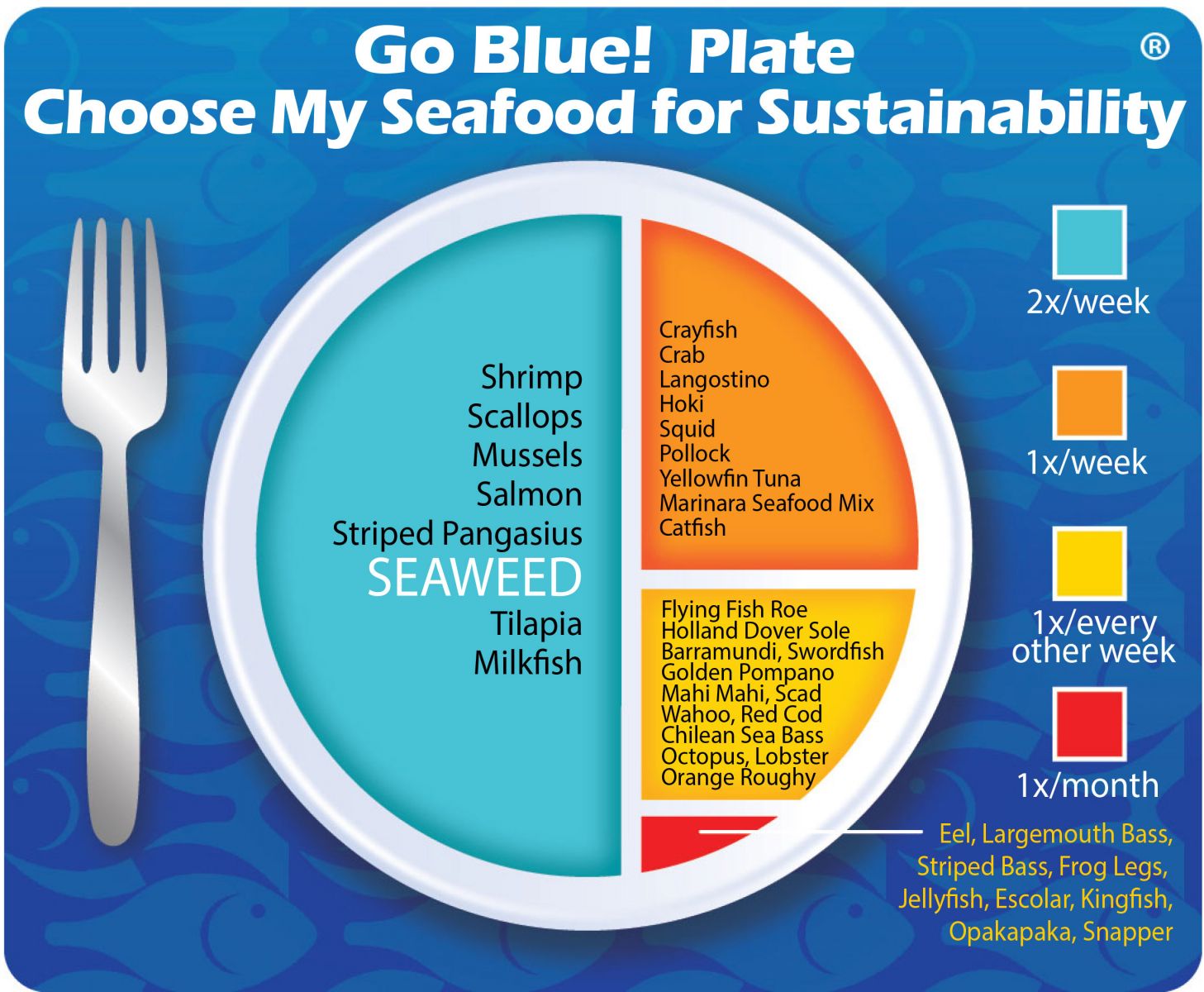
Sustainability Improvements NeededIt is preferable to source wakame from one of the countries where it is native, such as Korea, Japan, or China.
Actions that Sea Port is UndertakingSea Port is increasing its marketing of this nutritional super food and believes that doing so will help promote the expansion of this fundamentally sustainable seafood. Sea Port promotes the increased consumption of all low level trophic seafood such as wakame. Sea Port believes that, in aggregate, choosing from a diverse variety of seafood is better for sustaining the world’s seafood resources and Wakame Seasoned Seaweed Salad needs to be a part of this variety. We created the sustainability assessments for each of our seafood items in order to reveal the existing and potential environmental impacts and risks that are associated with producing them for human consumption. This allowed us to establish the starting position for each of our seafood items along our progressive Go Blue! Seafood Sustainability Spectrum®. These assessments are only a single snapshot in time and because of this, we will continue to assess and update the critical sustainability needs associated with our supply sources and issue updates to the Go Blue! Seafood Sustainability Spectrum® as needed. There is a growing global awareness for the need to assure the sustainability of farmed and wild caught seafood and because of this; all around the world positive changes are rapidly occurring at all levels of the seafood supply chain. We will continue to spread this growing awareness and work with our many industry partners to improve the sustainability of all seafood, which we believe is the ideal protein of choice to feed an ever growing world population. Our Go Blue! Seafood Sustainability Spectrum® serves as our compass and yardstick as we strive to move all our products forward to becoming more sustainable. Please join us in this committed quest and Catch Our Wave® to sustainability by choosing a diverse variety of responsibly produced seafood as part of your diet.
|



